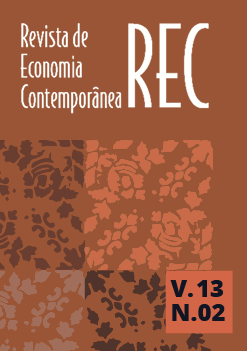O EFEITO FRONTEIRA DAS REGIÕES BRASILEIRAS: UMA APLICAÇÃO DO MODELO GRAVITACIONAL // THE BORDER EFFECT IN BRAZILIAN REGIONS: A GRAVITY MODEL APPROACH
Keywords:
comércio inter-regional, efeito fronteira, modelo gravitacional, integração regional // interregional trade, border effect, gravity model, regional integrationAbstract
RESUMO: Este artigo analisa o efeito fronteira do Brasil e de suas regiões para o ano 1999. Esse efeito foi estimado empiricamente, utilizando-se dados de corte seccional, em um modelo gravitacional com os 26 estados brasileiros, mais o Distrito Federal e 40 países. Apesar de o Brasil ter se engajado em um processo de abertura comercial, como o ocorrido durante a década de 1990, e ter participado de Acordos Preferenciais de Comércio importantes como o Mercosul, constatou-se que o país e algumas de suas regiões apresentam elevados custos de fronteira. Os resultados encontrados indicam que o comércio entre estados brasileiros é 33 vezes superior ao comércio internacional desses estados. Para as regiões brasileiras, o efeito fronteira das regiões Norte e Nordeste é significativamente maior do que aquele observado nas regiões Sul e Sudeste.
ABSTRACT: This paper analyzes the border effect for Brazilian goods market and its regions in 1999. This effect was quantified empirically by using cross-sectional data in a gravitational model for twenty-six Brazilian states plus the Federal District and forty other countries. Despite Brazil’s involvement in commercial opening in the 90’s, as well as important regional trade agreements such as Mercosul, we noticed that Brazil and some of its regions have high cross-border costs. The finding results of this equation suggest a trade 33 times higher between Brazilian states than the international trade of these states. Regarding each Brazilian region, the border effect found for intra-national trade among Northeast and North regions is significantly higher than the border effect for Southeast and Southern regions.


